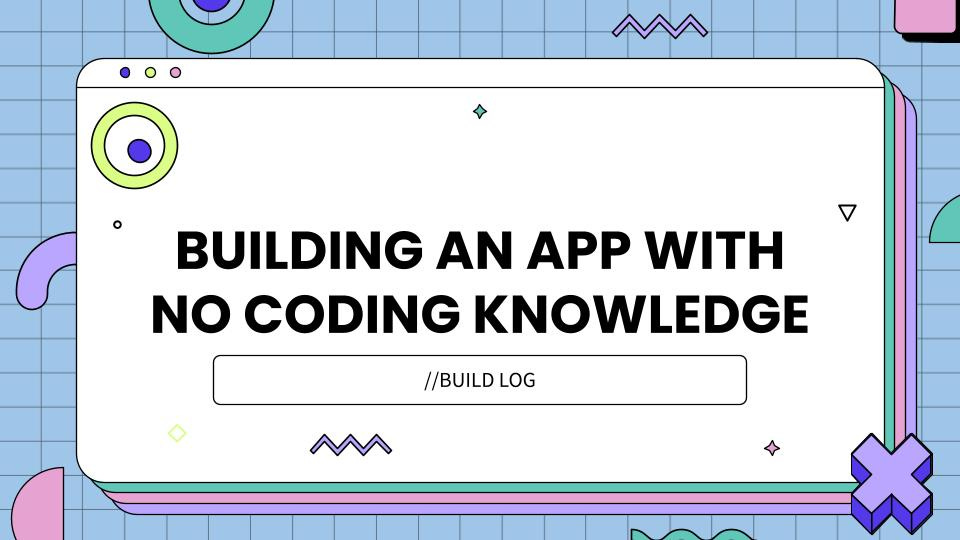Welcome to Build Log, where I document “Operation make Becky relevant again” aka my forays into keeping up-to-date with this whole AI thing. For the next few weeks, my big project is going to be building an app… with no coding experience.
How This Started
I had this conversation with a person I really wanted to work with today:
👨🏻💻: Do you know how to code?
Me: Nope.
👨🏻💻: Well, I want to build this app. Do you think you can do it?
Me: I guess???
The last time I wrote any code was middle school, using Dreamweaver and building websites with HTML, CSS, and PHP. Dude suggested I use ChatGPT as a personal tutor and go from there. The closest thing I know on how to do this was that
had a “Build apps with AI” course using Cursor. I’d love to take it, but I can’t afford it at the moment, so I’m figuring things out on my own with TutorGPT.The Project: AI-Powered YouTube Producer
The idea:
✅ Scrape YouTube videos from a given channel.
✅ Analyze trending content (based on views, engagement, etc.).
✅ Use AI to suggest video title ideas based on what’s working.
This is something YouTube creators already do manually, so we wanted to automate it.
What I Attempted Today
1️⃣ Setting Up a Backend (aka: What’s an API?)
GPT told me to get APIs. I know what it does in theory - it’s like a key to “enter” a system and let two applications talk to each other. Kind of. But I had GPT explain it to me again anyways:
An API (Application Programming Interface) is a way for different programs to talk to each other. Think of it like a restaurant menu: you request something (like data), and the kitchen (server) delivers it.
I needed an API so I could input a YouTube channel URL and get back scraped video titles + AI-generated ideas.
To do this, I used FastAPI, a tool that makes it easy to build APIs in Python. I asked GPT what FastAPI is:
FastAPI is like a “plug-and-play” way to create an API. It gives you a nice structure for handling requests, and it even comes with a built-in testing page (Swagger UI) so you don’t have to guess if your API is working.
How I tested it:
FastAPI automatically creates a Swagger UI, which is a visual tool where you can test API requests.
I opened
http://127.0.0.1:8000/docsin my browser.Typed in a YouTube channel URL.
Hit “Execute” and waited for the magic to happen.
It didn’t work.
2️⃣ Scraping YouTube (aka: Why Websites Hate Bots)
Originally, I used BeautifulSoup, a Python tool that reads website HTML and extracts information. But it failed.
Error: “No videos found. YouTube might have changed its structure.”
After asking ChatGPT what went wrong, I learned that YouTube changes its webpage structure often, and static HTML scraping isn’t reliable.
Fix: Switching to yt-dlp
yt-dlp is a Python tool built for downloading YouTube videos, but it can also extract metadata like video titles, URLs, and views.
I installed it (pip install yt-dlp) and rewrote my scraper to use it instead.
3️⃣ Adding AI for Video Ideas (Plugging in OpenAI)
Next, I wanted GPT-4 to generate new video titles based on trending content.
I asked ChatGPT: “How do I connect OpenAI’s API to my app?”
First, get an API key from OpenAI. Then use
openai.ChatCompletion.create()to generate text based on a prompt.
I followed these instructions but kept getting errors.
Error: “You tried to access
openai.ChatCompletion, but this method has been removed.”
Fix: Updating OpenAI’s API
Turns out, OpenAI changed how their API works in version 1.0.
I had to:
Upgrade OpenAI (
pip install --upgrade openai).Rewrite the function using the new API format.
I still got errors though… but I decided to end the day here.
Things I Learned Today
🔹 APIs are like menus—you send a request, and the server responds with data.
🔹 Scraping YouTube is tricky—static HTML scrapers like BeautifulSoup often break.
🔹 yt-dlp is way better for getting YouTube video data.
🔹 OpenAI updates can break old code—always check for API changes.
What’s Next?
GPT says this is what I should do next:
🔜 Deploying the API (so I don’t have to run it locally).
🔜 Adding engagement metrics (views, likes, etc.).
🔜 Building a simple front-end UI for non-coders.
Final Thoughts
I’m still not a coder, but with ChatGPT as my tutor, I could get somewhere… maybe?
idk let’s see where this goes. Here’s to trying to figure AI out :”)



